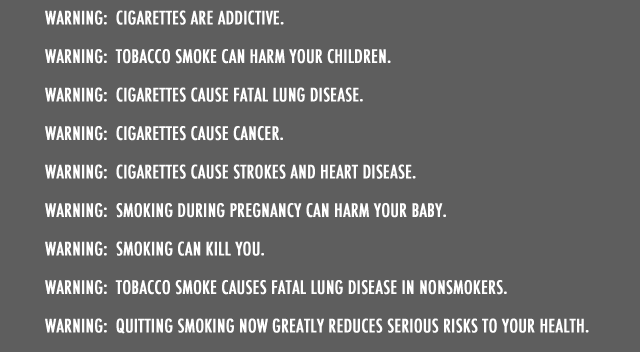Smokers Under Fire

By Jonathan Candelaria
Bronx Journal Staff Writer
Remember the days when people could take out a cigarette and smoke carefree? When the only hint at a cigarette’s toxicity was an occasional finger-wagging television commercial? Remember a time when smokers weren’t constantly bombarded with the consequences of their actions?
Those hazy halcyon days are now a distant memory, and could be replaced by a nightmare-inspiring, in-your-face reality check, courtesy of the Food and Drug Administration (FDA).
With the passing of the Family Smoking Prevention and Tobacco Control Act in June 2009, the life of the everyday smoker changed. This law stated that, in 2012, cigarette distributors would be required to install new warning labels on all packaging.
The Tobacco Control Act requires that nine graphic health warnings appear on the upper portion of the front and rear panels of every cigarette pack. The warning must comprise at least the top 50 percent of these panels.
Nine text warnings will accompany the graphic images:

The accompanying images are currently being narrowed down from a pool of 36 to nine through a phase of Public Commentary, according to the FDA. The FDA is the government agency that oversees public health and regulates the manufacturing, marketing and distribution of tobacco products.
“What we’re in now is what we call Public Commentary, where we’re actually listening to the public, to industry, and state clerk groups and getting their feedback on which particular images we will pair off with text warnings,” says Jeffrey Ventura, spokesperson for the FDA.
(Warning: FDA Cigarette Health Advisories May Cause Queasiness, Anxiety and Night Sweats)
This public commentary won’t be evaluated until January 2011, but across the Bronx people are already speaking their minds. Some found the grim images a little heavy-handed and excessive.
“I don’t think any of them will make smokers quit,” says Raven Rodriguez, an 18-year-old non-smoker. “The whole idea is contradictory. You can’t advertise how addictive a substance is by using vulgar images and slogans. Cigarette smokers are already highly aware of the repercussions of smoking. They have an addiction, they aren’t ignorant.”
When asked which of the the proposed images for the campaign she found most compelling, Rodriguez replied, “They’re all equally non-effective in my eyes.”

Smokers were divided on the warnings and their impact.
“I find it kind of sad that we’ve gotten to a point where such drastic measures need to be taken, but I see the benefits from this being greater than the drawbacks, which seem very minor,” said smoker, Ilya Varentsov. “These extremely graphic images coupled with the very straightforward messages in place can definitely convince many of those that are ignorant to possibly quit smoking.”
While some of the images are very controversial and disturbing others seem cartoonish. “The least effective labels would be the ones that are cartoon or look like they are drawn. To many smokers these animated messages won’t be as eye catching as something realistic, something more personal to them than a child-like drawing,” Varentsov explains.

Some of the more horrifying images include a cancer patient lying lifeless on a hospital bed, a man smoking with smoke coming out of a hole in his throat, and a photo of a toe-tagged corpse. Of the Bronx smokers polled, these images seem to have the biggest impact and made a few think twice about their favorite vice.
“In terms of legit and effective pictures, there is none more greater than a picture of someone dying of cancer,” said Jason Fouchecourt, who has smoked on and off during the past decade. “I was motivated when I saw the picture, and frightened. That daunting image is going to stay with me the rest of the day.”
All in all, there appeared to be a split between people who thought that smokers were already aware of the dangers that they are putting themselves in and people who thought that this could be a positive form of education.
Philip Morris USA, the largest tobacco company in the U.S., states that it supports the FDA in its decision-making and that it will continue to oversee the agency’s actions so that it will continue to be fair.
According to a Philip Morris statement, the company says it will follow the new regulations closely.
”The legislative process often involves compromise, and that is why we believe the law as enacted is not perfect. Among other things, we have consistently expressed our belief that certain provisions of the law cross constitutional limits. We are hopeful that these issues will be addressed as part of an ongoing collaborative process with the FDA and other stakeholders.”

Naturally, the tobacco companies will continue to fight for their right to sell cigarettes unencumbered by government regulation. This may reassure smokers for the moment, but there is still much at stake. With the recent ban on flavored tobacco products and the proposed ban by Mayor Bloomberg on smoking in parks or beaches, smokers continue to be under fire as the government fights to save them from their unhealthy hobby.
